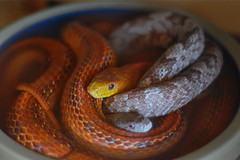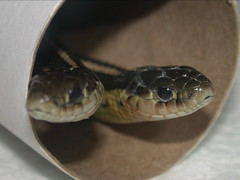The social life of snakes
When you go against the supposed rules and keep snakes two to a cage, you start accumulating anecdotal evidence about how snakes interact with one another. For the most part, a snake encountering another snake will either (1) eat it, (2) fuck it, or (3) ignore it. I do my best to avoid number one and keep breeding pairs together in hopes of number two; it’s number three that gets interesting, particularly in the cases of our four same-sex pairs of compatible rat and garter snakes.
 Many snake keepers have observed that a pair or trio of snakes will invariably hide in the same hide box, even if there are other, unoccupied hide boxes available. In other words, even when there’s plenty of room and plenty of places to hide, you’ll usually find two snakes curled up together. Forget about any ideas of snuggling or affection: that’s anthropomorphic thinking; as far as we know, snakes haven’t got the cognitive ability for that level of emotional interaction. What might be happening is one of the following: (1) two or more snakes independently conclude that a given spot is the perfect place to be right now, and they’re not put off by the presence of another snake; (2) the presence of another snake is confirmation that a given spot is a good one; or (3) the presence of another snake is reassuring and safe.
Many snake keepers have observed that a pair or trio of snakes will invariably hide in the same hide box, even if there are other, unoccupied hide boxes available. In other words, even when there’s plenty of room and plenty of places to hide, you’ll usually find two snakes curled up together. Forget about any ideas of snuggling or affection: that’s anthropomorphic thinking; as far as we know, snakes haven’t got the cognitive ability for that level of emotional interaction. What might be happening is one of the following: (1) two or more snakes independently conclude that a given spot is the perfect place to be right now, and they’re not put off by the presence of another snake; (2) the presence of another snake is confirmation that a given spot is a good one; or (3) the presence of another snake is reassuring and safe.
 It’s probably number one, though numbers two and three are intriguing. Snakes aggregate in the wild when good locations are scarce: Timber Rattlesnakes bask communally at good sites; northern species of every sort hibernate together in mass hibernation dens because safe places to hibernate aren’t easy to come by at those latitudes (this is the reason behind the Manitoba garter snake dens). I can’t help but wonder if the presence of other snakes has any impact on a snake’s decision making (“this must be the right spot if you guys are here”).
It’s probably number one, though numbers two and three are intriguing. Snakes aggregate in the wild when good locations are scarce: Timber Rattlesnakes bask communally at good sites; northern species of every sort hibernate together in mass hibernation dens because safe places to hibernate aren’t easy to come by at those latitudes (this is the reason behind the Manitoba garter snake dens). I can’t help but wonder if the presence of other snakes has any impact on a snake’s decision making (“this must be the right spot if you guys are here”).